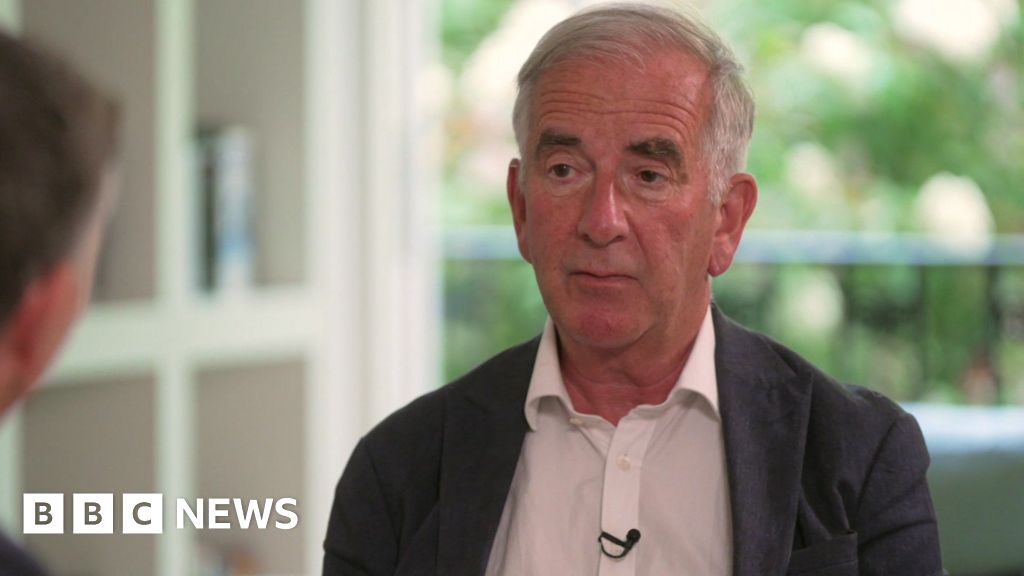WATCHING her latest purchase being carefully wrapped in Selfridges- branded tissue paper, Frankie Day had goosebumps of excitement. “As demand for this particular pop-up had been so high, I’d had to wait two weeks for a slot,” the full-time mum explains. “I was just so excited to finally make my selection.
” Charlie Day spent around £30,000 going to Disney Parks and buying memorabilia in 2024Women like Frankie Day, 31, above, form an enormous global community of adult Jellycat fans, with the company’s revenues skyrocketing by 37% in 2023 to £200millionHowever, the 31-year-old hadn’t travelled two hours from her home in Southampton to London to get her hands on a limited-edition handbag or high-end beauty product.She was on Selfridges’ fourth floor – the toy department – to splash her cash on Jellycats, the luxury, cuddly soft toys. “They’d created this brilliant fish and chip shop pop-up, where staff members ‘serve’ you Jellycat versions of the iconic meal.

“My haul included a super-cute Lily Fish, Dot and Peg Mushy Peas, and Cosy Chips, all wrapped up in Jellycat newspaper.” Once upon a time, an adult woman revealing an obsession with stuffed toys would have raised eyebrows, but nowadays, women like Frankie form an enormous global community of adult Jellycat fans, with the company’s revenues skyrocketing by 37% in 2023 to £200million. They’re even causing a crime wave.
In February, Ruby Smith, 35, from Suffolk, was given a suspended prison sentence for stealing almost £3,000 worth of toys from different Norfolk garden centres. Seeing how valuable “Jellies” have become, with one special-edition Dixie Bashful Bunny currently on sale on eBay for an eyewatering £2,398, it’s little wonder criminals have turned their sights on the popular plushies. If it seems incredible that anyone would pay so much for a children’s cuddly toy, then you haven’t met a kidult, AKA an adult who likes doing or buying things intended for children.
And in 2025, the kidult economy is booming. Generation X – generally seen as people born between 1965 and 1980 – love nothing more than jumping into adults-only ball pools or bouncing the night away at trampoline parks. Millennials – born between 1981 and 1996 – are hiring slime experts to organise “slime and wine” events or running around an 18+ soft-play centre.
When it comes to toys, it’s the over-18s who are really splashing the cash. Frédérique Tutt, global industry advisor for market research company Circana, says sales to kidults now account for nearly £1 in every £3 spent on toys – an eye-watering £1.05billion in the last 12 months alone.
‘The world was suddenly a scary place, but with my Jellycats, I felt safe’ That doesn’t surprise Frankie. She owns 100 Jellycat toys and still remembers her very first one. “I was 14, it was a zebra, and I had to convince my grandad to lend me £15 to buy it.
“I fell in love with the Jellycat soft feel and super-cute faces.” When she was 19, Frankie moved in with her partner Danny, now 33, and her six Jellycats went into a box because there wasn’t space for them beside the couple’s bed – and he thought they were a bit odd. Frankie forgot all about them, until three years later when she saw one in a shop and decided to have a look at hers.
“Opening the box and seeing them again, I had the loveliest feeling. “It was just so nice to cuddle them and see them back on my bedside table. I couldn’t resist buying more,” she says.
By the time their daughter Rebekah was born in May 2019, Frankie had around 30 Jellycats. But it was the pandemic, not becoming a mother, that put her collecting into overdrive – until she had over 100. “The world was suddenly a scary place, thanks to Covid, but with my Jellycats, I felt safe.
“It gave me a lot of comfort to buy them and see their numbers grow.“I also set up a Facebook group for other Jellycat fans, which now has 1,500 people on it.” The ‘forever young’ adult is in part a response to shifting economic realities.
Many Millennials and younger Generation X-ers face huge financial pressures that delay traditional markers of adulthood.Tina Chummun, Psychotherapist In late 2020, when the family moved into a three-bedroom flat, Frankie decided it was time to give her expanding collection a room of their own. “It’s such a calming place to be.
Life as an adult has its ups and downs, but when I’m feeling stressed or worried, going into my room and arranging the Jellycats instantly makes me feel like a kid again,” she says.“I may have had an argument with Danny or been worried about Rebekah, but the second I start organising the Jellies by colours or size, I’m transported back to childhood, when life was much simpler. “When Rebekah was born, I did buy her some Jellycats of her own.
“But seeing them get played with and become grubby, I decided to put mine on a high shelf out of her way.“I’ve never had to say to her: ‘These are Mummy’s, so please don’t touch them.’ She just knows,” Frankie explains.
Frankie spends between £50 and £200 a month on expanding her Jellycat collectionWhile the kidult trend spans both Millennials and Generation X, a 2024 YouGov report found that the average age of those engaging with kidult brands online is 36.7. And the majority are female – something that doesn’t surprise Nicole Booz, author of The Kidult Handbook.
”Women have historically been expected to mature quickly, take on caregiving roles, and suppress playfulness,” she explains. “Kidulthood is a way to reclaim joy on our own terms. “It’s also deeply tied to self-care.
“Women are prioritising what makes them happy, whether that’s watching their favourite childhood movies or collecting plushies.” Psychotherapist Tina Chummun is clear that there are significant benefits to indulging in so-called childish activities. “Nostalgia serves as an emotional regulator, offering comfort in uncertain times,” she explains.
“In a world that feels increasingly unpredictable, revisiting childhood favourites can trigger a sense of safety and belonging.” Fun facts you didn't know about Jellycat Jellycat was created in 1999 by brothers Thomas and William Gatacre.They come in seven sizes from tiny at 13cm to very big at 108cm.
One of the most iconic plush toys is the “Bashful Bunny”, a soft and cuddly rabbit with long ears!The most popular Jellycat is “Bashful Beige Bunny”.The rarest Jellycat is said to be “Bashful Bunny Imogen” – released in 2011, it’s a lilac bunny that is worth £600+ now.Snow Dragon is another rare toy – released in 2020, the brand doesn’t make dragons often and plushie collectors are desperate to find.
Slackajack Monkey is the Jellycat that’s been around the longest – 21 years to be exact! According to Statista, Jellycat recorded a revenue of almost £200 million in 2023. As for the factors driving the recent kidult explosion, Tina believes one of the biggest is the rocketing cost of living. “The ‘forever young’ adult is in part a response to shifting economic realities.
“Many Millennials and younger Generation X-ers face huge financial pressures that delay traditional markers of adulthood.“That makes it easier, and sometimes necessary, to seek joy in accessible, low-stakes pleasures.” Amber Hay, 30, an events organiser from St Albans, loves her life of holidays, eating out and weekends away – all things she admits she’d never be able to do if she didn’t live at home with her mum and dad.
“I love living at home, cooking with Mum and getting lifts from Dad, and have no plans to move out any time soon,” she says. “I moved in with my then-boyfriend for six months aged 27, and I was paying £1,200 a month for a tiny studio flat. “But now I’m back home, I pay just £250 a month and, as I have a much larger disposable income, this allows me to travel more.
“In the last two years I’ve been to Ibiza, America and a family holiday skiing in Switzerland.” Amber Hay, with her mother Natalie, still lives at home despite being 30 – and has no plans to move out as she can now afford holidaysAmber’s sister Sasha, 26, and brother Dylan, 20, also refuse to fly the nestAmber isn’t the only adult child to still be at the family home – her sister Sasha, 26, a model and business development manager, and brother Dylan, 20, a lettings agent, also refuse to fly the nest. “Mum makes it so nice, we don’t want to leave!” Amber says.
“She loves cooking for us and lets my boyfriend stay here as well.“Although she sometimes despairs of us all, she says the house would feel empty without us. “My friends are either shocked when I tell them about my living arrangements and say they couldn’t still be living with their parents, or are envious of my amazing set-up.
“But more of my friends in their early 30s are now moving back home, so they can save for a house or because the cost of living is just so high.” While Amber clearly loves living with her mum and dad, Tina believes that for others, the situation can be problematic. “I’m 49 and when I go back to my parents’ house, I unconsciously slip back into the role of being a child.
“Those family dynamics are powerful and can make you stagnate if you stay in them for too long.“If a ‘forever young adult’ misses their moment to leave home and be independent, it can mean they struggle to ever find their feet in their life.” But, she says, stepping back into the embrace of childhood temporarily can be powerful in the very best way.
Charlie Day says her love for Disney makes her happy as an adult, and she now shares the joy with son ErnieThis is something that happens every time Charlie Day, 36, catches sight of Disney’s Cinderella Castle. “It was a huge deal for my family when we all went to Disneyland Paris when I was four,” remembers the business owner from London. “When the fireworks finished, the compere announced that if you believed in Disney magic hard enough, when you opened your eyes, you’d see Tinkerbell flying over the castle.
“When I saw her – a physical ‘fairy’ being pulled over the castle – it was pure joy.” Charlie started collecting Florida travel brochures and dreamed of visiting Walt Disney World, which she did when she was eight years old. “The whole holiday was incredible.
As soon as we walked through the gates at the Magic Kingdom Park, we all felt happy and free. We made some amazing memories,” she says. By the time she met her husband Lewis, now 36, in a nightclub in March 2011, when she was 21, Charlie’s love of Disney was clear to see.
He didn’t understand why, as an adult, I loved Disney so much. He didn’t get that the movies, the music, the souvenirs, all made me happy. Charlie Day, 36“Lewis walked into my bedroom, saw a Tinkerbell duvet cover and a Disney star toy with the slogan: ‘Believe in your dreams,’ and was clearly a bit taken aback!” she remembers.
The pair fell in love quickly, despite Lewis’ insistence that, when they moved in together six months later, she ditch the Tinkerbell duvet. “He didn’t understand why, as an adult, I loved Disney so much. “He didn’t get that the movies, the music, the souvenirs, all made me happy.
“But when we went on our first Disney cruise together in 2012, I won a medal at the musical quiz, and he saw my face light up at the Little Mermaid show, and he realised then that Disney is a fundamental part of who I am. You can’t love me without it,” Charlie says. The couple tied the knot in August 2015 (she even dressed up as Minnie Mouse on her hen do), and by the time their son Ernie was born in December the following year, the couple had been on 10 Disney cruises, costing around £70,000.
“Becoming a dad helped Lewis really fall in love with Disney and we’ve taken Ernie to the parks in Paris, Florida, California and Hong Kong, as well as on four Disney cruises. “He could see it through Ernie’s eyes and understood that when you’re walking into the parks, you’re transported into a different world. “Outside, things can feel scary, but step through the gates, and it’s all left behind.
” ‘Our two-week trip to Florida, including a suite at a top Disney hotel, will cost £32,000’ Practical and ambitious, Charlie sees Disney as both a motivation for success and a reward for it. “Since 2019, I’ve created a manifestation vision board each January, and Disney is always on it,” she says. “The more successful my business Charlie Day Sales is, the bigger and more frequent our holidays can be.
” In 2024, she spent over £30,000 on Disney. “That included holidays to Florida and Paris, a cruise, a trip to Disney On Ice and lots of memorabilia.“This year our two-week trip to Florida, including an exclusive firework event and a suite at the top Disney hotel, will cost us £32,000.
” He did raise an eyebrow to see me spending between £50 and £200 a month on them. Then someone got in touch with me after seeing a picture of my collection on Instagram, and offered me £850 for a big lilac bunny. He was amazedFrankie Day, 31Even Lewis is on board, although he does put his foot down occasionally.
“I recently discovered that if you get married at a particular Disney hotel, Mickey Mouse gives you away at the ceremony.“I said: ‘Let’s do that for our 10th wedding anniversary!’ But he thought that was a step too far.” For Frankie’s partner Danny, who works in a hospital pharmacy, his conversion came when he realised how much her numerous Jellycat toys were worth.
“He did raise an eyebrow to see me spending between £50 and £200 a month on them. “Then someone got in touch with me after seeing a picture of my collection on Instagram, and offered me £850 for a big lilac bunny. “He was amazed.
“I’ve probably spent more than £3,000 on my collection over the years. “But I never look at my Jellies and see a price tag. “The comfort and happiness they bring me is priceless, and whether I’m 31 or 91, I know that will never change.
“If that makes me a kidult, I’ll wear that label with pride.”.
Entertainment

Rise of the ‘kidult’ trend that sees young women eschew adulthood for Jellycat, Disney & shacking back up with mum & dad















